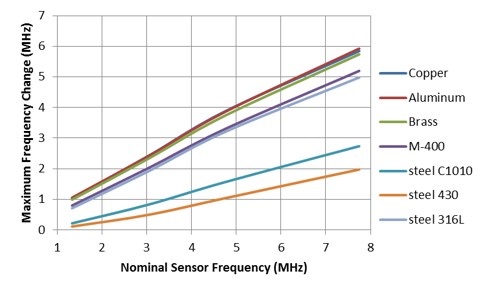SNOAAA5 April 2024 DRV8220 , FDC1004-Q1 , LDC3114-Q1 , TMAG5131-Q1 , TMAG5173-Q1 , TMAG6180-Q1
- 1
- Abstract
- Trademarks
- 1Introduction
- 2Automotive Door Handle Architectures
- 3Functional Demo Design
- 4Detailed Design Flow for Door Handle Functions
- 5Summary
- 6References
4.4.3 Target Material
A material with higher electrical conductivity (σ) - such as copper, aluminum or silver - is a better target for inductive sensing technologies because the amount of eddy currents generated on the target are directly related to conductivity (σ) of the target material. A thin layer of conductive material can be added on to non-conductive materials like plastic to make effective targets for push-button applications. Figure 4-26 illustrates the sensitivity of the LDC to the conductivity of the material through the dependence of the sensor frequency shift (which the LDC detects) on the target material and the sensor frequency (which impacts the skin effect). Note the two best conductors - copper and aluminum - give the greatest frequency shift over all sensor frequencies. The LDC Target Design application note provides additional details, and the spreadsheet-based LDC Sensing Design Calculator Tool lets you calculate and model the effects of target conductivity and thickness.
A thinner or less rigid target material requires less force than a thicker or more rigid one. The spreadsheet tool also allows you to model the deflection produced in the target surface with a given amount of force that is inversely proportional to the tensile strength and thickness of the material. If we modify our previous example (target: 20mm diameter, 1mm thick) to a thickness of 0.5mm, the target deflection under 1 Newton of applied force increases from 0.1um to 0.880um. Please be sure to check the desired target thickness against the eddy current depth through the tool's SkinDepth tab. If a target is too thin to support approximately 3 skin depths, it can degrade the button sensitivity.
 Figure 4-26 Target-Induced Frequency Shift
vs Nominal Sensor Frequency with Target Material as a Parameter
Figure 4-26 Target-Induced Frequency Shift
vs Nominal Sensor Frequency with Target Material as a Parameter